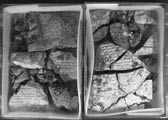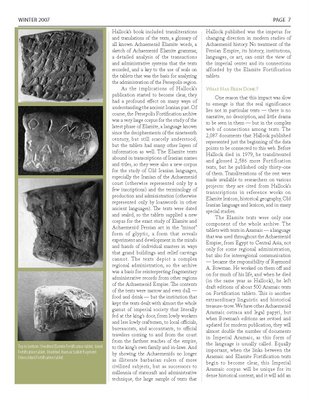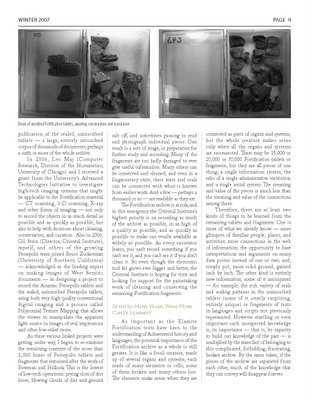
Gil J. Stein, Director, Oriental Institute
[See also What are the Persepolis Fortification Tablets? by Matthew W. Stolper]
The Persepolis Fortification texts have seen two firestorms. The first was the burning of the Persian capital by Alexander the Great in 329/330 B.C. After surviving this destruction, the tablets now face a second conflagration — a legal battle that could well lead to the dismemberment of this unique archive if it is seized, auctioned off piecemeal, and disappears into the holdings of private art collectors around the world. This latter threat is quite real and could lead to the loss of the single most important surviving source of information about the organization of the 2,500 year old Persian Empire of Cyrus, Darius, and Xerxes. If this actually happens, it would be a loss to science of unprecedented scale, and it would rob the Iranian people of one of the most important symbols of their cultural heritage and identity. But the tablets speak to concerns far beyond those of the Iranian people — in fact, this legacy of the Persian Empire foms a key part of the golden thread that links the ancient Near East, the Judeo-Christian traditions of the Bible, and the emergence of Greek and Western civilization. As such, the fate of these tablets should be of greatest concern to every thinking individual. The Oriental Institute and the University of Chicago are absolutely determined to protect the integrity of this remarkable archive as both a unique scholarly resource and as a touchstone of world cultural heritage. How did this dusty trove of unbaked clay cuneiform-impressed tablets become embroiled in controversy and threatened in this way?

From Takht-i-Jamshid to Chicago: The Odyssey of the Persepolis Tablets
As described so well by Professor Matthew Stolper in the accompanying article in this issue of News & Notes, one of the greatest accomplishments of the Oriental Institute is surely its excavations during the 1930s at Takht-i-Jamshid — ancient Persepolis, the 2,500 year old monumental capital of the Achaemenid Persian Empire. During the 1933 season of excavations, Ernst Herzfeld and his team from the Oriental Institute discovered a deposit containing tens of thousands of unbaked clay tablets and badly broken tablet fragments impressed with writing in a cuneiform script; the trove was found in one of the rooms of the northern Fortification wall surrounding the palaces, treasuries, and temples of Persepolis. The Persepolis tablets are tremendously important for two reasons. First, they are a unique resource for scholarship. Until their discovery, our main written sources for the Persian Empire were those written by foreigners — notably the Hebrew Bible and Greek sources such as Herodotus and historians of Alexander’s campaigns. These accounts,quite naturally, gave a partial and biased picture of the Persian Empire. A handful of monumental carved stone inscriptions by Darius and Xerxes at Bisitun and on the palace walls of Persepolis itself were the only real records written by the Persians. With the discovery of the Persepolis Fortification tablets, researchers were finally able to get an understanding of the everyday life and internal workings of the Achaemenid imperial organization, as described by the Persians themselves. The tablets also bear thousands of seal impressions. Since the archive is securely dated within a very narrow time range (from 509 to 494 B.C. in the reign of Darius I), this allows art historians to precisely date the use of specific art styles, while interpreting them as a related body of art aimed at presenting the official and unofficial ideologies and belief systems of the Achaemenid imperial elite.
But the Persepolis tablets also have a very deep modern significance as irreplaceable items of cultural heritage for the people of Iran. Persepolis and the Persian Empire are the central symbols of Iranian cultural identity. The greatness of the Achaemenid Empire is deeplyengrained in Iranians’ very definition of who they are as a people and their important role in the history of civilization. To this day, names such as “Cyrus” or “Darius” are common in Iran, and every Iranian is aware of the significance of the site of Takht-i-Jamshid, as Persepolis is known in the Farsi language. The Persepolis texts, as the actual records of the government of the Persian king Darius, resonate for Iranians at a very profound level. In other words, these are items of cultural heritage as important as the crown jewels of England, or the original document of the Magna Carta, or the Western Wall in Jerusalem, or the Parthenon in Athens.
It was therefore an extraordinary act of trust and international scholarly cooperation in 1936, when the Iranian government allowed the tablets to be brought to the Oriental Institute on a long-term loan for purposes of translation and analysis. The texts were recovered from the ground in an extremely fragile and often fragmentary state. The massive quantity, fragile physical condition, and the challenges of reading the texts have made their analysis and publication a difficult, long-term project that has extended for seventy years and is still far from completion. The vast majority of the tablets are written in a late dialect of Elamite, the oldest written language of Iran. This extremely difficult language can be read by only a tiny number of highly- trained researchers, perhaps no more than twenty or so throughout the world. It took decades before Oriental Institute scholar Richard Hallock was able to decipher the script effectively and publish the first set of about 2,000 tablets. The texts are the abbreviated records of the issuance of food rations to various functionaries in order to supply them as they traveled or worked on behalf of the Achaemenid imperial administration. This makes it extremely difficult to understand the contents of the texts, even if one can actually read the written words — one might compare it to the challenge of a person from another country trying to make sense of thousands of cash-register receipts from a supermarket. Would they know that the phrase “ ½ gal 2 pct” refers to “ one-half gallon of low-fat (2%) milk”? Professor Hallock famously summarized the difficulty of working with the Persepolis texts when he remarked “if you’re not confused, then you clearly don’t understand the problem.”
Despite these challenges, by dint of sheer brilliance and persistence, Hallock and other scholars slowly started to crack the code of the Persepolis tablets, and as they did so, they revolutionized Achaemenid studies to give the world its first understanding of the Persian Empire in the actual words of the long-dead Persians themselves. Professor Matthew Stolper of the Oriental Institute now bears the primary responsibility for the analysis and translation of the tablets.
Return of the Texts
From the time of the tablets’ first arrival in Chicago, researchers at the Oriental Institute were keenly aware of the texts’ importance as the cultural heritage of the Iranian people, and of their scholarly responsibility not only to translate the tablets but also to ensure their return as loan objects back to Iran once their analysis and recording were complete. Professor George Cameron returned the first set of 179 tablets in 1948. A second shipment of more than 37,000 tablet f ragments followed in 1951. In May 2004, a team consisting of myself, Laura D’Alessandro, Head of Conservation, and William Harms from the University of Chicago News Office returned an additional 300 complete tablets to the National Museum in Tehran. At this point, by our best estimates, more than two thirds of the Persepolis Fortification texts have been returned to Iran.There now remain approximately 8,000 tablets and 11,000 poorlypreserved fragments of the unbaked clay tablets awaiting analysis at the Oriental Institute.

Top to bottom: Gil J. Stein and Mohammad Beheshti, Director of the Iranian Cultural Heritage Organization, signing receipt for the tablets. Gil J. Stein and Mohammad Beheshti after signing the document. Sharokh Razmjou and Madame Zahra Jaffar-Mohammadi of the Iranian National Musem and the Oriental Institute’s Laura D’Alessandro inspecting the tablets after their return. Madame Zahra Jaffar-Mohammadi, William Harms, Director of the Iranian National Museum, Reza Kargar, and Laura D’Alessandro. Photo credits: top three William Harms, bottom Gil Stein.
The most recent return of loaned tablets in 2004 received extensive and highly favorable coverage in the international media. It therefore came as a complete shock when several months later the Oriental Institute was served with legal documents demanding that it surrender the Persepolis tablets to satisfy the legal claims for damages in a lawsuit by victims of a Hamas bombing attack in Israel.
The Oriental Institute found itself caught in the middle of a complex legal drama that began in Jerusalem in 1997 and is now playing out in a Federal courthouse in Chicago. In 1997, a group of American tourists fell victim to a bombing attack in Jerusalem. Five people lost their lives, and many others were badly injured. The Palestinian organization Hamas claimed responsibility for the bombing. The surviving victims and the families of those who died argued that the Islamic republic of Iran had funded Hamas and should therefore be held accountable to pay compensation. When the case was heard in Rhode Island Federal court, representatives of the state of Iran did not appear to contest the case. As a result, a default judgment was entered against Iran for over $400 million in damages. Because the tablets are on loan from Iran to the Oriental Institute, the plaintiffs are attempting to appropriate and sell them to satisfy the claim for damages. The case is currently in litigation.
At the Oriental Institute and the University of Chicago, we feel the deepest sympathy for the victims of the terrorist attack. However, we do not believe that the law allows for the seizure of cultural heritage as compensation. The tablets are not commercial assets like oil wells, tankers, or houses. Instead, these types of culturally unique and important materials fall within a special protected category and are not subject to seizure.
It is important to note that the U.S. State Department has twice made submissions to the court in which our government supports the University o f Chic ago’s reading of the law. Representatives of the Iranian government have also appeared in court to assert the special protected status of the Persepolis tablets that exempts them from this type of legal action. At this point, with the court case ongoing, the tablets are not in any immediate threat of confiscation and sale. However the longer-term danger remains very serious and real.
Where We Stand
The Oriental Institute will do everything in its power to protect cultural patrimony and the character of the tablets as an irreplaceable scholarly data set. The Persepolis Fortification tablets were legallyexcavated in the 1930s and exported with the permission of the Iranian government. This trove of tablets has never been a commercial item to be bought or sold. They have never been a source of profit to either Iran or the Oriental Institute. They are non-commercial items of cultural heritage every bit as unique and important as the original document of the Constitution of the United States. The stakes are enormous. If the lawsuit prevails, this would do irrevocable harm to scholarly cooperation and cultural exchanges throughout the world. We have a responsibility of stewardship for items of cultural heritage such as the Persepolis tablets. These fragile records have miraculously survived the burning of Persepolis by Alexander the Great. It is extraordinary that they were found and scientifically excavated. They are the only archive of their kind in the world. It is our responsibility as both scientists and as responsible citizens to protect them for future generations. This is the shared heritage of all people.
The protection of cultural heritage and of scholarly research are fundamental matters of principle for the Oriental Institute and the University of Chicago, as they should be for every civilized person and nation. This is certainly the widelyheld view of the scholarly community and of international institutions such as UNESCO. We firmly believe that cultural heritage and scholarship must transcend politics.
I am confident that common sense and our reading of the law will ultimately prevail in this matter, and that the Persepolis tablets will remain intact as both a unique source for scholarship, and as a jewel of cultural heritage.
[Following are the pages of these articles in the format in which they were originally published in The Oriental Institute News and Notes. The full issue is now online: 2007 Winter (#192)]








1 comment:
Post a Comment